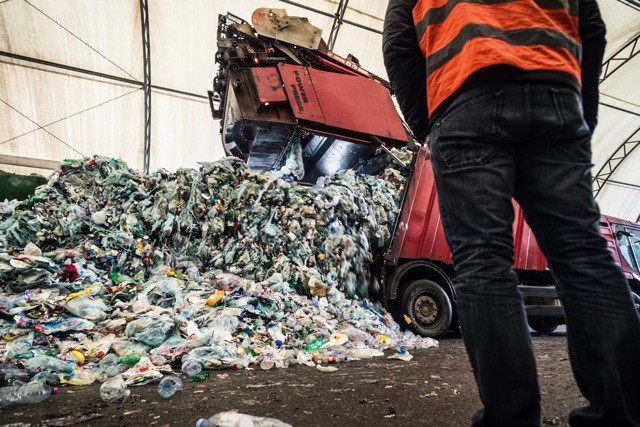The first step is at the Hein Déchets sorting plant in Bech-Kleinmacher beside the Moselle where Delano was given a tour on a wet afternoon in January.
Besides the clunking and grinding of 60 or so machines, the first thing to stand out at the site is the smell. A pungent rotten sweetness mingled with sour milk. It is to be expected considering 14,000 tonnes of household waste from Luxembourg homes are sorted here every year.
The blue bags are transported daily and at peak times stored in a 2,500m2 open hangar, before being moved to the first stage of the impressive industrial-scale sorting machine in a warehouse next door. Hein Déchets operations head Tobias Wilhelm explains that when the centre first opened in 1999, sorting around 1,000 tonnes of waste, staff would empty them by hand. In that respect robotisation has improved things considerably.
We follow a truck as it drops bags on a belt for the first sorting stage, where the contents are emptied. That’s where the fun starts, with material passing through an array of ingenious sorting stages using vacuum suction, six optic sorters, perforated drums, magnets and even people. These processes will separate first the plastic labels, bags and films, then the metal from the plastic and drinks cartons and their sub categories at a dizzying speed. “The conveyor belt moves at around 3 metres a second. There’s no point in monitoring it because it goes so fast,” Wilhelm says.

Photo: Mike Zenari
He and Valorlux collections chief Alain Heynen guide the photographer and myself up some metal steps to a platform, when everything suddenly falls silent. It is then I realise just how noisy the process is. Such interruptions for maintenance or repairs, though not common, are problematic since the sorting process can only work when all machines are functional--and as with any business, time is money. “There are around 60 machines with different elements. The installation only works if all 60 machines work together,” Wilhelm stresses.
Minutes later, the machinery fires up and our guide is again forced to shout to be heard over the mechanical sound. We pass along a platform to the last station, where PEHD plastic, the type used for cosmetics or cleaning materials, are sorted. This is where we find the only people, beside those driving the waste around the site, at work in the process. Around two people remove the “residue of sorting”, rogue items like yoghurt pots which cannot be processed. “It’s incinerated to make energy,” Heynen says. Once enough materials of a specific element have been sorted, a compressor applies 80 tonnes to the mass, wraps them in wire and pushes out bales.

Photo: Mike Zenari
The bales are stacked in colourful avenues in the centre of the site, to be transported to clients which will transform them into new products. “Turnover is so fast we don’t leave them out for three weeks. And the bales are so compact little water gets into them,” Heynen says. The price per tonne Valorlux gets for the materials is set by an exchange. Heynen says most of the materials are rarely sold beyond the neighbouring countries as a matter of principle.
Future waste
Whether it is because of rampant overconsumption or the impact of cross-border mobility, Luxembourg was the fifth biggest waster in the EU in 2016, throwing away on average 480kg of waste. Just under a third of waste was recycled. Valorlux, which introduced the blue bag system in 1997, represents 90% of the companies generating packaging waste in Luxembourg.
In 2016, it recycled more than 71% of packaging generated by its members through the bags, recycling parks and Rebox containers in supermarket car parks. “The challenge is to maintain this recycling rate and to improve it,” Heynen says, adding: “For now we’re OK but we must look to the future”.
While the rate is well above the 2008 European Commission goal of 55%, the goalposts will likely shift in future. In preparation for this, a green bag pilot project has been rolled out in 20 communes, broadening the scope of items that can be sorted and recycled to include plastic bags and films. What is more, the sorting site will be modernised and expanded later this year, with further automated processes to increase sorting capacity to 25,000 tonnes per year.

Photo: Mike Zenari
As Luxembourg’s population grows, the amount of packaging waste it generates is expected to increase, but a number of projects have been put in place to slow this down.
In addition to the country’s first packaging-free store, Ouni, which opened in 2016, Valorlux invests heavily in education and prevention. It encourages the use of eco bags, a concept which we will no doubt be more attached to by 2024, when the number of plastic bags per person will be limited to 40--right now we use around 140.
Valorlux also has a number of awareness-raising tools, like the phone app and the fun valorluxjunior.lu website, where kids and adults can virtually sort their waste.
